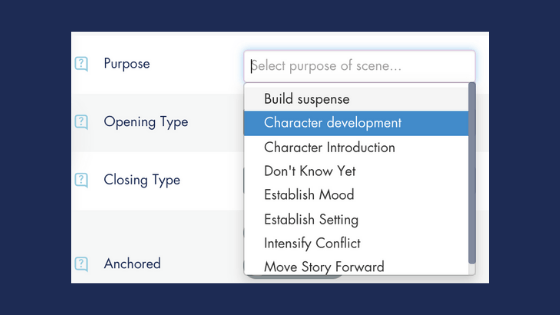Naming each scene will help you tighten your plot. Here’s how.
Let’s Start With What Is A Scene
A scene is a section of your novel where a character or characters engage in action or dialogue. You can think of a scene as a story with a beginning, middle, and an end.
And On To Plot…
To tighten plot, you must know what plot is. Plot describes the events that take place in your story. The events occur in a sequence, and that sequence forms the structure of your novel. You’ll most likely have a main plot and one or two subplots. Your protagonist (main character) follows the main plot. Secondary characters follow the subplots.
And Then Scenes And Plot…
The purpose of the scene must relate to the overall story. If it’s not driving the story forward, ask yourself why you included the scene in your novel. StoryTeller gives you a list to choose from or you can add your own.

When a scene causes a plot hole by not being connected to the story, this usually means the scene doesn’t have a purpose. If you don’t know the purpose of each scene in your story then neither will your reader.
Naming the scene will help you determine what the scene is about. The scene name should represent the main theme or main action of the scene. It should be something you can read and immediately know what happens in the scene.
Name each scene using three words or fewer.
Naming the scene will create an outline you can reference as you edit.
A list of scene names is also helpful when you’re evaluating the structure of the novel. You can scan the list and analyze if the scenes appear in the best order to create suspense.

A chapter may contain one scene or many scenes. Usually, the scenes within a chapter are related. Some novels have one scene per chapter for the entire story. Others have multiple scenes.

Where you start a new scene will influence the experience you give to your readers.
Usually, you’ll start a new scene when you change the point of view character, who is in the scene, the storyline, the scene location, or the time.
Tighten the Plot with Elements Of A Scene – And Where to Look for Names
Characters
Most likely you have at least one character in a scene. The character doesn’t have to be a human. It could be a storm. It could be a haunted house. It could be an animal. You get the idea. Whatever is it, if you give “it” a scene, “it” must be something relevant to the story
Characters entering or exiting a scene are a good place to start or end the scene.
Plot
Each scene needs a great opening line, an entry hook, a middle, a climax and an exit hook.
Consider starting a new scene when the direction of the story changes, the action is significantly different, or you’re sharing a subplot.
Setting
The scene must take place somewhere. When the location changes, consider starting a new scene.

More Help to Name Scenes
C.S Lakin has some great advice to name the first 10 scenes you need in a novel. You can use this to name 10 of your scenes. StoryTeller lets you do this right beside your text. You don’t have to use an extra spreadsheet or printed paper.
Perform a Story Edit With Fictionary StoryTeller
StoryTeller is creative editing software for fiction writers. Transform your story, not just your words. Successful stories depend on your ability to edit, improve, and revise your work. Only when you master story editing, can you master storytelling.
Why not check out Fictionary’s StoryTeller free 14-day trial and tell powerful stories?
Thanks for reading!


